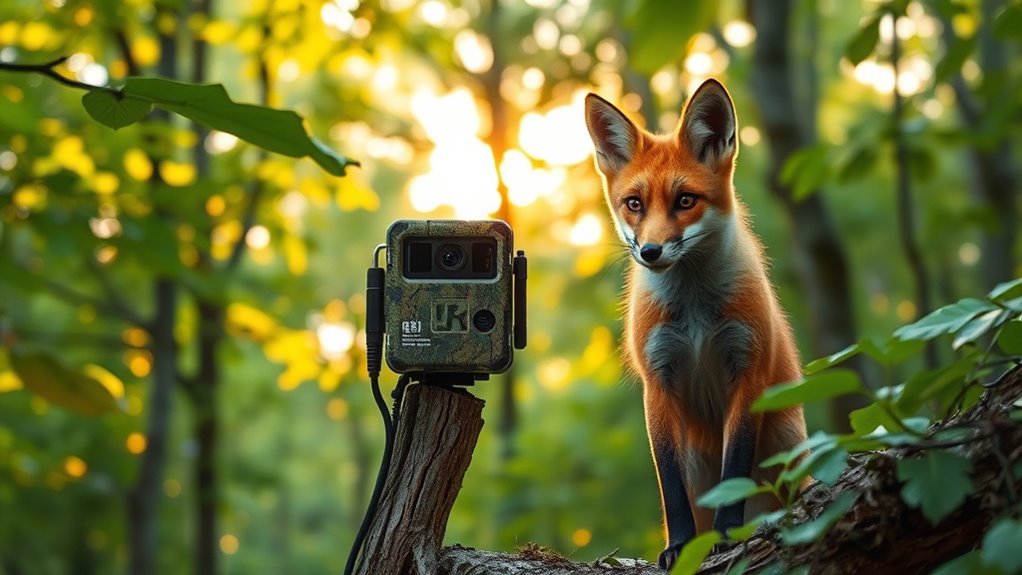Edge‑AI wildlife cameras are revolutionizing conservation by enabling you to detect threats like poaching or invasive species in real time. These smart, low-power systems analyze images locally, sending instant alerts via satellite or cellular networks, so you can respond quickly. They operate autonomously for months in tough environments, improving protection for endangered species. Keep exploring to discover how these innovative tools are transforming wildlife monitoring and conservation efforts worldwide.
Key Takeaways
- Edge‑AI wildlife cameras enable real-time species detection and threat alerts directly in remote environments, reducing reliance on cloud connectivity.
- They utilize high-performance, low-power hardware like Nvidia Jetson Nano for autonomous, months-long operation in tough field conditions.
- Integrated communication modules (cellular, LoRaWAN, satellite) allow instant data transmission and rapid conservation responses to threats.
- Onboard AI algorithms analyze images locally to identify poaching, invasive species, or distressed animals instantly, enabling quick intervention.
- These systems are affordable, scalable, and designed for community-driven conservation efforts, enhancing global wildlife monitoring.
The Rise of Edge‑AI in Wildlife Monitoring

The rise of Edge‑AI in wildlife monitoring is transforming how conservationists track and protect species. Edge AI allows wildlife cameras to process images locally, reducing dependence on unreliable cloud connections and enabling real-time detection. High-performance hardware such as Nvidia Jetson Nano enables the deployment of sophisticated AI models directly on the device. With onboard AI algorithms, systems like Sentinel use low-power devices such as Raspberry Pi and Nvidia Jetson Nano to identify threats like poaching and invasive species in remote areas. By integrating edge AI with satellite, cellular, and LoRaWAN communication, these cameras can instantly transmit critical alerts and data, allowing swift conservation responses. Designed for months-long autonomous operation with minimal power, edge AI-powered cameras excel in harsh, inaccessible environments. This technology not only improves detection accuracy but also enhances the timeliness of conservation efforts, making a significant impact on wildlife protection. Incorporating reliable power sources ensures continuous operation in the most challenging conditions, maximizing the effectiveness of these monitoring systems. Additionally, robust environmental resilience enables devices to withstand extreme weather and coastal conditions, further supporting long-term conservation initiatives. Moreover, advancements in energy efficiency contribute to reducing the overall power consumption of these devices, extending their operational lifespan. Furthermore, the integration of self-learning algorithms can improve detection capabilities over time, adapting to new threats and environmental changes.
Key Features of Smart Camera Traps for Conservation
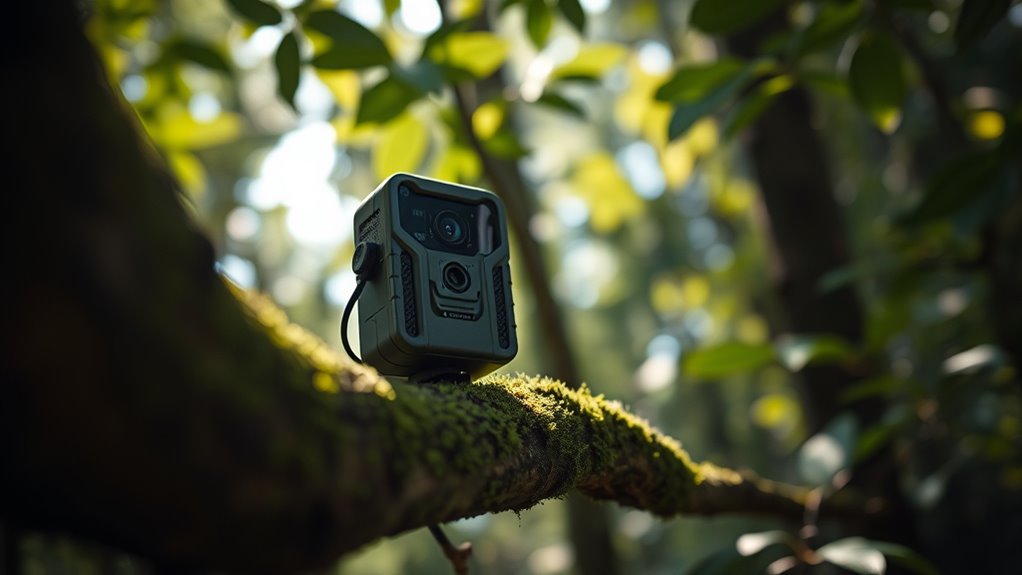
Smart camera traps equipped with onboard AI enable you to detect and classify wildlife species automatically in real-time, eliminating the need for manual review of images. These cameras use low-power inference pipelines like TensorFlow Lite, allowing them to operate for months on small batteries in remote areas. They are built with off-the-shelf hardware components, making deployment affordable and straightforward across various conservation sites. Features such as wireless communication via cellular or LoRaWAN enable instant alerts and image transmission, supporting quick conservation responses. Their integrated AI algorithms improve accuracy, durability, and data collection efficiency in tough field conditions. Additionally, maintaining regular maintenance practices can enhance the longevity and performance of these devices, ensuring consistent data collection in challenging environments. Incorporating community involvement can further expand the impact and sustainability of conservation initiatives, leveraging local knowledge and support. Furthermore, utilizing user-friendly interfaces can help field teams operate the technology more effectively and with less training. Implementing robust security measures is also essential to protect sensitive wildlife data and device integrity in remote deployments.
How Autonomous Detection Enhances Field Research
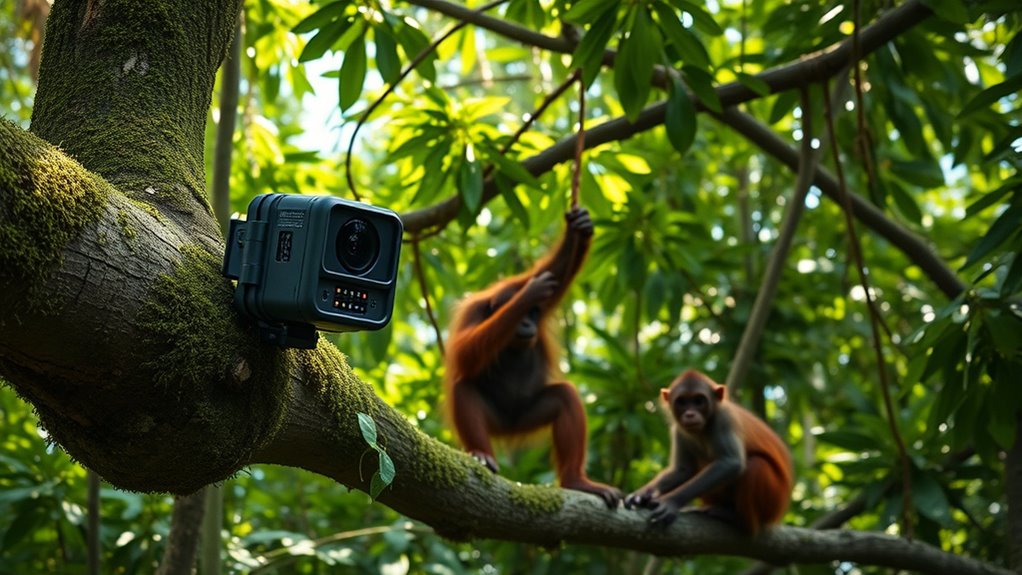
Autonomous detection transforms field research by allowing wildlife cameras to analyze images and videos on-site in real-time. This means you can identify species or threats instantly without waiting for manual review. A growing concern with AI deployment is ensuring its trustworthiness, especially in sensitive conservation applications. This real-time analysis accelerates decision-making, enabling rapid responses to poaching or invasive species. AI-powered cameras filter out irrelevant footage through onboard detection algorithms, conserving storage and transmission bandwidth, and giving you focused data. These systems can operate continuously in remote, harsh environments without needing constant human oversight or network connectivity. By providing timely insights, autonomous detection improves data accuracy and supports adaptive monitoring strategies. Additionally, the integration of AI security measures ensures that these systems remain reliable and resistant to tampering, which is crucial for maintaining trust in conservation efforts. Implementing robust algorithms further enhances system resilience against errors or malicious interference. Moreover, ongoing advancements in edge computing enable more sophisticated processing capabilities directly on the device, reducing latency and dependency on remote servers. Ultimately, it enhances your ability to gather critical information efficiently, making field research more effective and responsive to dynamic wildlife conservation challenges.
Integrating Connectivity for Real‑Time Threat Alerts
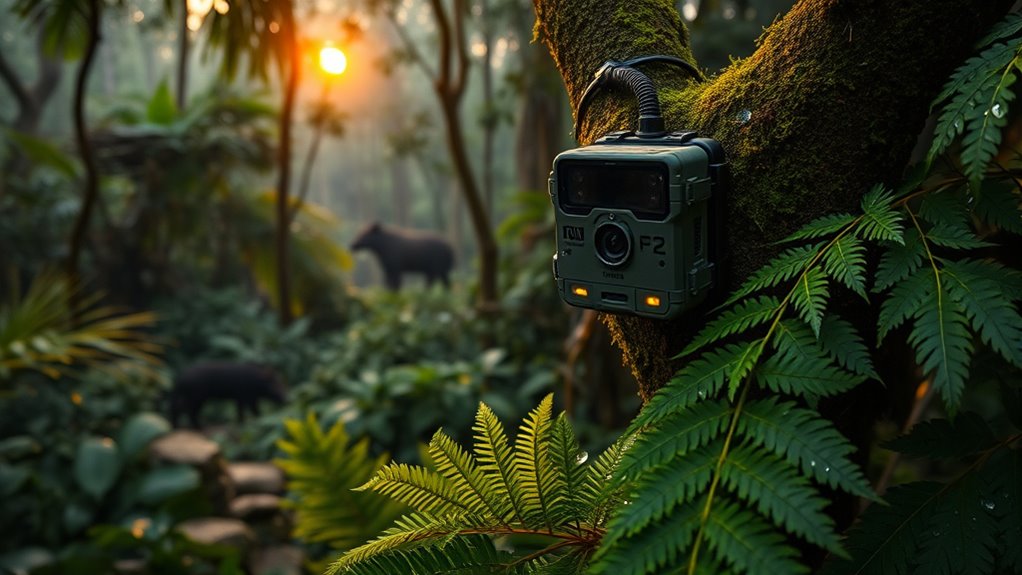
Connecting wildlife cameras with cellular, satellite, or low-power networks lets you get instant alerts about threats like poaching or invasive species. This real-time communication accelerates conservation responses and reduces delays caused by manual data checks. Incorporating nutrient-rich ingredients into your conservation strategies can further enhance ecosystem health and resilience. Additionally, leveraging conservation technology can optimize monitoring efforts and improve data accuracy.
Connectivity Technologies Employed
To enable real-time threat alerts in remote wildlife habitats, edge AI cameras incorporate various connectivity technologies such as NB-IoT, LoRaWAN, cellular modules, and satellite links. These connectivity solutions allow your camera traps to transmit data efficiently, even in areas with limited power sources. State-specific tax laws can influence how you plan your conservation budget and data management strategies. Low-power modules like CELL-LINK CABLE and Trail Guard AI ensure continuous communication, enabling swift alerts when threats or wildlife activity are detected. The integration of diverse connectivity options guarantees your edge AI camera traps operate reliably over extended periods, supporting ongoing conservation efforts with minimal maintenance and maximum data sharing capabilities. Additionally, understanding survivalism principles can help in planning backup power sources and emergency protocols for field deployments. Incorporating robust communication methods can further enhance the resilience of your systems in remote environments.
Real-Time Alert Mechanisms
Edge AI wildlife cameras leverage integrated connectivity modules like cellular, LoRaWAN, and satellite links to deliver real-time threat alerts directly to conservation teams. These real-time alerts enable you to act quickly against threats such as poaching, invasive species, or the presence of endangered animals.
The onboard edge-AI algorithms identify unusual activity and immediately transmit notifications, reducing response times and enhancing situational awareness. You can visualize these alerts through platforms like EarthRanger, which helps coordinate rapid conservation efforts.
Impact on Conservation Efforts
Integrating connectivity such as cellular, satellite, and LoRaWAN with wildlife cameras markedly enhances conservation efforts by enabling real-time threat alerts. This connectivity allows your cameras to instantly transmit alerts about poaching, invasive species, or other threats directly to conservation teams.
With real-time alerts, response times drop from hours to minutes, boosting your ability to protect vulnerable species and habitats. These connected cameras improve situational awareness, helping you deploy personnel or resources quickly when needed. Additionally, remote monitoring becomes more effective, reducing the need for physical presence in protected areas. The data collected and transmitted through connectivity supports better decision-making, adaptive management, and overall conservation success. Implementing tuning in camera systems can optimize performance and reliability in diverse environmental conditions, ensuring consistent operation in remote locations. It is also essential to consider environmental durability to maintain operation in harsh outdoor settings, further enhancing the system’s effectiveness. Moreover, leveraging connectivity options can expand coverage and ensure continuous data flow, even in challenging terrains. Incorporating power management strategies can further improve system longevity in remote environments. Furthermore, advancements in battery technology contribute to longer operational periods, decreasing maintenance needs. It’s a game-changer for wildlife conservation, making efforts faster, smarter, and more efficient.
Impact of Edge‑AI on Protecting Endangered Species
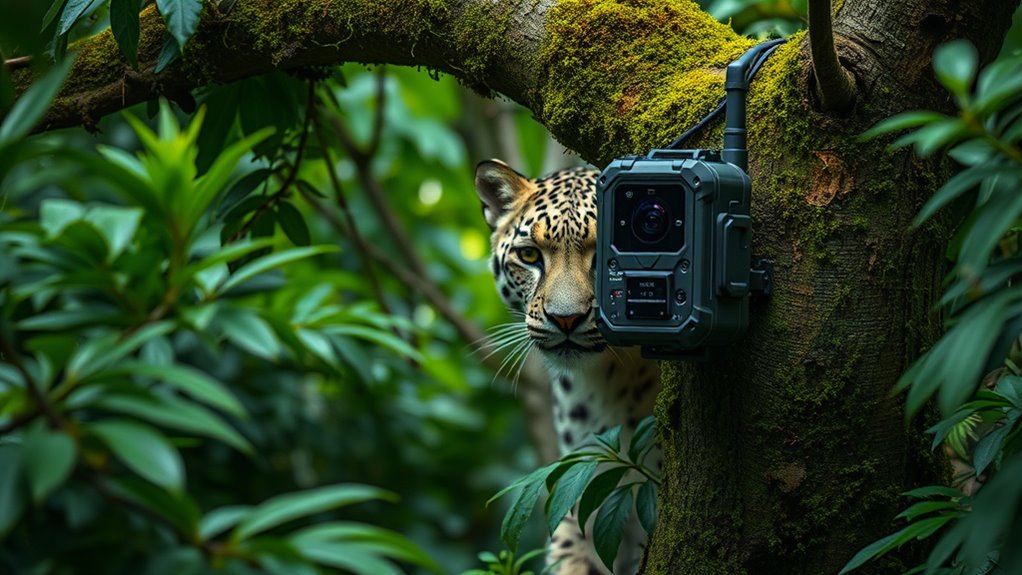
Edge-AI wildlife cameras let you detect threats to endangered species instantly, so you can act quickly. They improve your ability to monitor elusive animals and catch poaching in real time. A supportive environment is essential for effective conservation efforts, and these cameras help foster that by enabling rapid response and protection.
Real-Time Threat Detection
Real-time threat detection has transformed wildlife conservation by allowing cameras to identify dangers instantly, without waiting for human intervention. Edge-AI wildlife cameras can autonomously spot threats like poaching or invasive species, sending conservation alerts immediately.
Imagine a camera recognizing:
- A poacher lurking near a protected zone, triggering an instant alert.
- An invasive species threatening native flora, prompting rapid action.
- Endangered animals in distress, alerting rangers to intervene swiftly.
These cameras use onboard AI algorithms such as MobileNetV2 and SSD to analyze images locally, reducing response times from hours to minutes.
The ability to deliver real-time threat detection guarantees that conservationists can act proactively, preventing illegal activities and safeguarding vulnerable species before significant harm occurs.
Enhancing Field Responsiveness
By analyzing data locally, Edge-AI wildlife cameras enable conservation teams to respond immediately to threats, rather than waiting hours or days for remote alerts. This real-time monitoring allows you to quickly identify poaching activity or invasive species incursions through AI analysis of camera trap images.
The onboard processing provides instant alerts, ensuring rapid intervention during critical moments. With autonomous detection capabilities, these cameras reduce response times from days to minutes, substantially increasing the chances of protecting endangered species.
You can trust that the AI-driven system offers continuous situational awareness, empowering you to make swift, data-driven decisions. Ultimately, this enhanced field responsiveness helps prevent illegal activities and preserves essential habitats more effectively.
Future Directions in Conservation Technology

As conservation efforts embrace technological innovation, future advancements will heavily rely on open-source, affordable edge AI platforms like Edge Impulse to enable scalable wildlife monitoring in even the most remote areas.
You’ll see improvements in:
- Deploying low-power hardware combined with IoT connectivity (like LoRaWAN) to gather data continuously without traditional infrastructure.
- Training AI models on diverse datasets to boost species identification accuracy and detect ecological threats early.
- Democratizing conservation technology through open-source hardware and software, empowering local communities and researchers to craft tailored solutions.
These innovations will make conservation technology more robust, energy-efficient, and easier to deploy, supporting large-scale, real-time wildlife monitoring worldwide. Your efforts will become more precise, accessible, and effective in protecting ecosystems.
Frequently Asked Questions
How Do Edge‑Ai Cameras Handle False Positives in Wildlife Detection?
You might wonder how false positives are managed in wildlife detection. Typically, edge-AI cameras use advanced algorithms trained on diverse datasets to distinguish animals from other objects or movements.
They often incorporate real-time filtering and threshold adjustments to minimize errors. Additionally, some cameras allow you to review triggered images, helping you refine the system over time for better accuracy and fewer false alarms, ensuring reliable wildlife monitoring.
What Are the Power Sources Commonly Used for These Remote Devices?
Power sources for remote devices are the lifeblood that keeps them running smoothly. You’ll commonly find solar panels capturing sunlight, batteries providing portable energy, and sometimes hybrid systems combining both.
Solar panels are eco-friendly and ideal for long-term use, while batteries offer flexibility in shaded areas. You might also see small wind turbines in windy locations.
These energy options guarantee your wildlife cameras stay active and reliable, even in the most remote corners.
Can Edge‑Ai Cameras Operate Effectively in Extreme Environmental Conditions?
You might wonder if these cameras work well in harsh environments. They’re designed with durable materials and advanced technology that help them withstand extreme conditions like heat, cold, or moisture.
Features such as weatherproof enclosures, temperature regulation, and shock resistance guarantee reliable operation. While no device is entirely immune to all conditions, edge‑AI cameras are increasingly capable of functioning effectively in challenging environments, making them valuable tools for remote monitoring.
How Is Data Securely Stored and Transmitted From These Autonomous Devices?
Imagine data as a precious, fragile butterfly fluttering from remote cameras. You guarantee its safety by encrypting it before transmission, like locking a delicate box.
Secure storage involves local encrypted drives and cloud servers with strict access controls.
Transmitting data uses robust, tamper-proof protocols like TLS, ensuring the butterfly reaches its destination unscathed.
This layered security keeps your wildlife insights protected, even in the most isolated environments.
What Are the Costs Associated With Deploying Edge‑Ai Wildlife Monitoring Systems?
When you deploy edge‑AI wildlife monitoring systems, you need to take into account several costs. These include purchasing the cameras and AI hardware, installation, and ongoing maintenance.
Additionally, there might be expenses for software updates, data storage, and secure transmission. While initial investments can be high, these systems often reduce long-term costs by minimizing the need for human patrols and enabling real-time data analysis, ultimately supporting effective conservation efforts.
Conclusion
As you explore edge‑AI wildlife cameras, it’s clear they’re revolutionizing conservation efforts. Did you know that autonomous detection can reduce false triggers by up to 90%, saving valuable field time? By integrating real-time alerts and smart technology, you can better protect endangered species and respond swiftly to threats. Embracing this innovative tech empowers you to make a meaningful difference in wildlife preservation, ensuring these incredible creatures thrive for generations to come.
